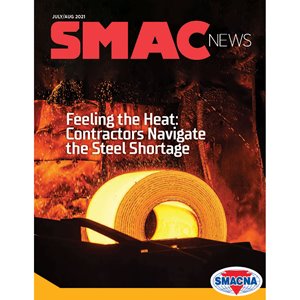From the President: Guiding Resources
First it was the supply chain, then lumber prices, then steel…and now the COVID-19 Delta Variant is set to add a lot of uncertainty into the third and fourth quarters of this year.
 First it was the supply chain, then lumber prices, then steel…and now the COVID-19 Delta Variant is set to add a lot of uncertainty into the third and fourth quarters of this year. The ripple effects of the pandemic are far reaching and apparently not yet over.
First it was the supply chain, then lumber prices, then steel…and now the COVID-19 Delta Variant is set to add a lot of uncertainty into the third and fourth quarters of this year. The ripple effects of the pandemic are far reaching and apparently not yet over.
Understanding the dynamics driving change in the economy during this phase of the pandemic is becoming a full-time job for many of us. For the past two months, I have had the opportunity to visit a number of chapters and discuss current events with contractors (It’s great to see people face-to-face again!). I have gotten the sense that we all have steady work, but we are not as busy as we were in the earlier part of the spring/summer.
Momentum has pulled back slightly due to several economic reasons including supply disruptions, rising costs of construction materials, fear of inflation, and a general hesitancy to invest at a time the world is reacting to the COVID-19 Delta Variant.
As I write this, there is general anticipation that the Senate’s infrastructure bill will be reconciled and voted on September 27, while the $3.5 trillion budget framework is still to be debated. The infusion of spending would be welcome for the growth opportunities it would bring.
The timing couldn’t be better as nonresidential construction costs have increased 23.4% compared to a year ago this time, according to Anirban Basu, CEO, Sage Policy Group. All of us were wondering about the steel market, and SMACNA responded with a deep dive into some of the causes.
SMACNA continues to monitor both economic and legislative activities, sharing their findings through a variety of valuable resources including their daily news email — Executive News Brief, timely webinars, Member Updates and Chapter Leadership News.
There are other indicators that you can also watch to help predict the upcoming economy. One such indicator is the AIA’s Architectural Billings Index. An article in this SMACNews issue takes contractors through this Index and shares why it is an important leading indicator for the pace of our work 12 months from now. If architects are not billing, then there are no new projects in the pipeline. Another key source listed in the cover story is the Fed’s Beige Book, which reports anecdotal information derived from bank branch directors, businesses, community organizations, economists, and market experts on current economic conditions in various regions.
Utilizing these economic indicators can help you benchmark your business activity to see if it is mirroring the economy, or if you should take a closer look at your operations and the competitive landscape around you and make some adjustments.
An overlooked resource I rely on to benchmark all this data is my peer group. Talking with trusted peers is a great way to get a good sense of business and economic conditions across the country. Our peer group examines both internal and external factors that drive business success. Check out the “Let’s Talk Shop” Podcast to hear my conversation with Matt Cramer and Jack Knox as we talk about our peer group. To find that, just search “peer” on SMACNA’s website. A good business owner is always trying to predict the future so we can be prepared for what is in front of us!
Sincerely,
Angie Simon, SMACNA President
Published: September 3, 2021
IN THIS ISSUE
ARCHITECTURAL: Architecture Billing Index, A Key Indicator of Construction Spending
The COVID-19 pandemic threw the brakes on the economy in 2020, shuttering businesses around the world and throwing millions of people out of work.
Capitol Hill Update: Main St. Efficiency Act | Davis-Bacon | COVID Reimbursement | School Retrofits
SMACNA joined leading business and efficiency groups in supporting small business efficiency upgrade incentives that will be simplified with the Main Street Efficiency Act of 2021.
Cooking Up Clarity
Bringing guidance to food processing industry projects was goal of new SMACNA guidelines.
From the President: Guiding Resources
First it was the supply chain, then lumber prices, then steel…and now the COVID-19 Delta Variant is set to add a lot of uncertainty into the third and fourth quarters of this year.
How Leaders Can Build Enduring Resilience
We’ve all heard the phrase, “It’s a marathon, not a sprint.”
HVAC and Sheet Metal Companies Navigate Steel Shortage
For nearly two years, the Covid-19 pandemic has triggered shortages of consumer goods in unexpected places. There were runs on cleaning products and toilet paper in the early days. Sporting goods stores have seen their selection of bicycles and
HVAC: Top Southeast Pediatric Healthcare System Taps Three SMACNA Members for New Campus
The Southeast’s top pediatric hospital system, Children’s Health of Atlanta (CHOA), will soon have a new hospital campus that provides advanced care for kids.
INDUSTRIAL: Industrial Safety: TAB Contractor Recognized
Beginning work at a nuclear power plant last year — the first new reactor construction in the United States since the Three Mile Island accident in 1979 — SMACNA contractor Research Air Flo expected heightened safety requirements.
RESIDENTIAL: Google Ads are a Great Way for Contractors to Gain New Business
For many contractors, Google Ads is a complex landscape, but with a couple of tips and tricks to simplify the process, Google Ads can be a very effective tool to gain new customers in new ways.
The 6 Most Common Mistakes Estimating Teams Make — and How to Overcome Them
The estimation process is critical to the success of any given project, but it’s also a leading indicator of the overall health of your construction business in the long term.
Upgrading Your Pre-Qualification Process to Today’s Market Demands
The purpose of a prequalification process is to evaluate whether a contractor is qualified to bid on a specific construction project.
Welcome New SMACNA Members


